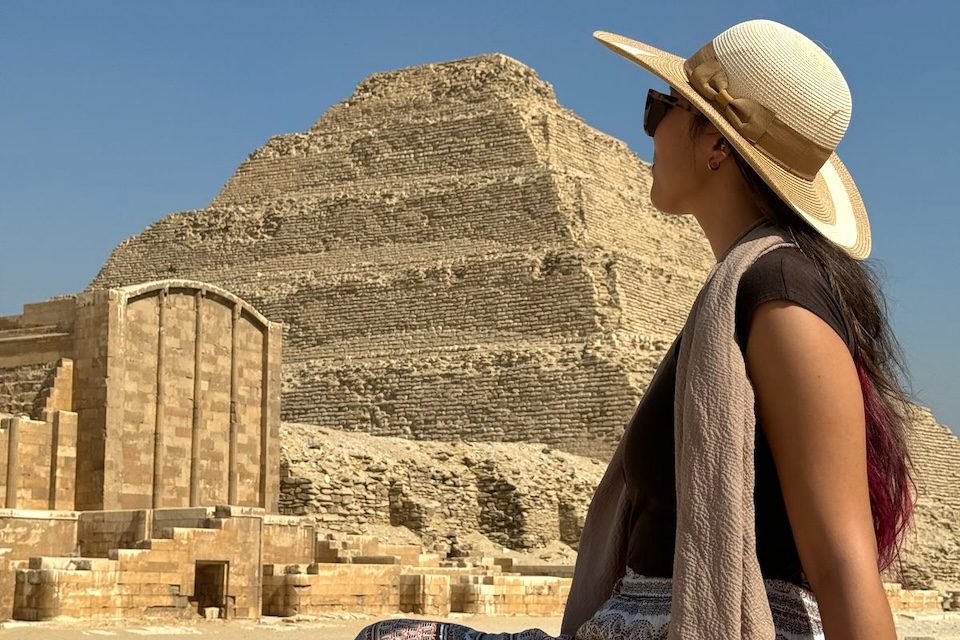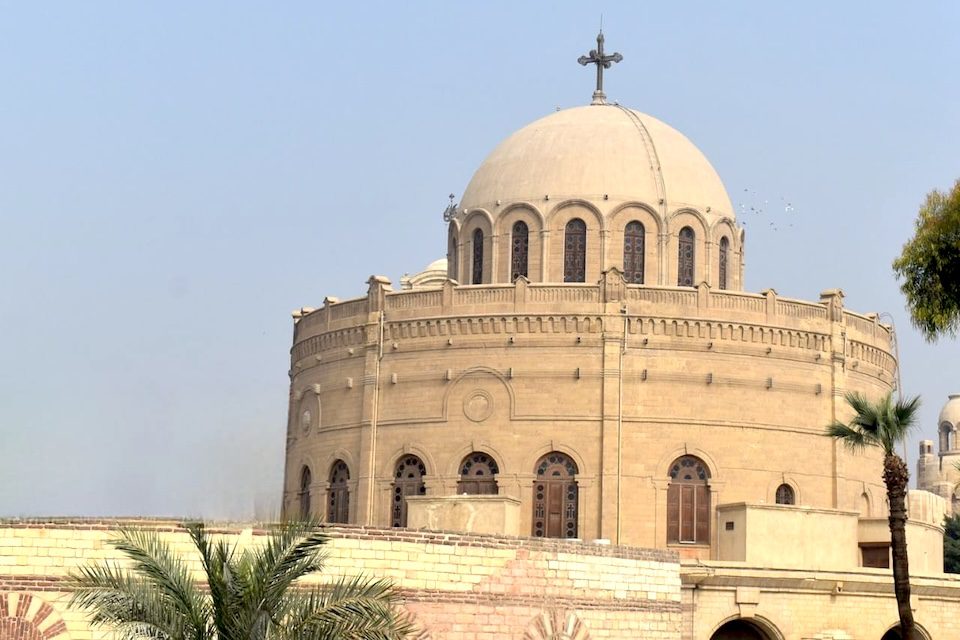Egypt's ancient civilization has left a mark on mankind's imagination as fertile and invigorating as the Nile Valley's path through the desert. The earth's warm-up after the ice Age had covered the land with tropical rainforest, but this dried out into the Sahara's arid wasteland, leaving only a few pockets of greenery at the oases and along the banks of the Nile River. It was there that stone Age hunters and fisherman settled to grow crops and rear cattle from about 3000 B.C. Their rulers, the pharaohs, untied north (lower)and south (upper) Egypt into one country with its capital moving from Memphis (just south of modern Cairo) to Thebes (Luxor).
Egypt became the dominant power in the eastern mediterranean for the next 1,500 years. Rich farmland and the treasures of its craftsmen attracted invaders from Palestine, Libya and Persia. The Greeks and Romans followed and then a long succession of Byzantines, Arabs, Turks, British and French until independence was achieved in the 20th century. The conquerors come and go and the pyramids still stand.

In 3000 BC, the Egyptians developed the art of writing, borrowed from trading partners in Mesopotamia (modern Iraq), into their own system of hieroglyphics. This combination of pictorial and phonetic symbols served not only to record prayers, hymns and other religious texts, but also to draw up inventory for the grain harvests and accounts for business. The top scribe was the pharaohs’ right-hand man. He combined his writing talents with those of high priest, doctor, astronomer, mathematician and architect. The most famous of them was Imhotep, who designed the first pyramid as a mausoleum for king Djoser at Saqqara, around 2680 Bc. This stepped structure was followed by king Cheops’ sheer-faced Great pyramid at nearby Giza. It faithfully reflects ed the pyramidal political system in which the divine pharaoh was the pinnacle and the people who built it formed the base.
Scholars divide the pharaohs into 30 dynasties, lasting 2,700 years. The 18th and 19th dynasties, from about 1500 to 1200Bc, represent the heyday of their political power and artistic glory. They built the great temples of Luxor and Karnak and extended Egypt’s empire northeast to Syria’s modern border with Turkey, west into Libya and south deep into the Nubian kingdom that is now Sudan. Queen Hatshepsut, the iron lady of Thebes, put on a false beard and made herself pharaoh. The mystic pharaoh Akhenaton and his lovely Nefertiti did away with the dozens of traditional gods to worship just one, a radiation of the sun. Tutankhamen restored the old cult, though his main achievement was to die at 19 and become immortalized as the only pharaoh whose treasure survived the grave robbers Ramses II was the greatest megalomaniac of them all, erecting gigantic monuments to himself throughout Egypt, most notably the colossal statues at Abu Simbel.
But it was the beginning of the slow end to pharaonic greatness. He was most probably the pharaoh who let Moses’ people go. The empire gradually shrank back to Egypt ‘s national borders as it was invaded in turn by the Libyans, Assyrians and Persians.
Alexander the Great arrived in 332Bc. No world conquest could be complete without Egypt. The Macedonian warrior marched in from Palestine and had himself crowned pharaoh at Memphis. Out in the western Desert, at the oasis of Siwa, a temple oracle told him he was the son of Amun, the supreme creator god. This morale booster prompted him to set off to conquer India. The Ptolemies who ruled after his death turned his capital, Alexandria, into the richest city of the ancient world.
Cleopatra, the most illustrious of their monarchs, decided that if she could not beat Julius Caesar, she would seduce him and then mark Antony, too. For a brief shining moment, she shared with him control of the eastern half of Rome’s empire. But their torrid affair ended in disaster in 30Bc. The Egyptian fleet was crushed by the romans and the lovers committed suicide. Augustus Caesar reduced Egypt to a provincial backwater of the Roman Empire.
According to church tradition, the evangelist Mark preached Christianity in Alexandria during the 1st century AD. Egyptian Christians, known as Copts, founded the first monasteries, seeking refuge in the desert from Roman and later Byzantine persecution. The Copts, under the leadership of the patriarch of Alexandria, were in constant theological and political conflict with the Greek orthodox church, which was based in Constantinople. The Byzantine emperors also ordered the closing and destruction of shrines still devoted to Egypt’s ancient gods. The last holdout was the cult of Isis, which continued among Nubians down at Aswan until the reign of Emperor Justinian (AD 527-565) After the Arab conquest of 641 AD, the Copts who did not convert to Islam could claim, by avoiding intermarriage with the newcomers, the people’s only unbroken link with their ancient Egyptian forefathers.

The desert nomad conquerors from Arabia had to reconcile their rough habits with the more sophisticated tastes of the Egyptians. It was left to Turks such as Ibn Tulun and the Fatimid dynasty from North Africa to bring a new, specifically Islamic style to Egyptian life. The capital, a military garrison at the southern trip the Delta, grew into the city of Cairo in 969 AD. It became the cultural center of the Islamic world as the Sheikhs added mosques, universities and palaces. The great Saladin (1171-93 AD) repelled the Christian crusaders and built Cairo’s citadel. The lusty warrior Mamelukes, raised from slaves to sultans, divided their time between beautifying their city with wonderful stone craving and killing each other in palace intrigues.
Things quietened down again with the advent of the Turks in 1517 AD. Their Ottoman empire ruled Egypt with a 1oose, not to say indolent hand. The sultan did not interfere from Istanbul when rebellious Mamelukes competed with his janissary warlords for control of the local Turkish pasha who was nominally in charge of Egypt’s affairs. For nearly three centuries, the country stagnated.
The French army of Napoleon Bonaparte blew into Egypt like a desert whirl wind in 1798 and blew out again when routed by the British in 1801 But in between, they brought about a veritable revolution in Egypt’s national consciousness, not with soldiers but with a company of 187 archaeologists, linguists, geographers, botanists and engineers. It was their pioneering excavations and research of Egyptian monuments and tombs which revealed to the world the full extent of the nation’s ancient greatness. Their discovery of the Rosetta stone, quickly confiscated by The British as the spoils of war, enabled a young French scholar, Jean Francois Champollion, to break the cipher of hieroglyphics in 1822.
Not quite light enough on his feet to float like a butterfly and sting like a bee, Egypt’s Mohammed Ali nevertheless proved a tough fighter When it came to asserting his country’s autonomy vis-à-vis the Ottoman Turks. In 40 years, government, he modernized the army and public education and streamlined the cotton industry and agriculture for export. But this upset European business interests. British gunboat diplomacy forced the Egyptians to content themselves with producing raw materials for Manchester; meanwhile the French smooth talked Mohammed Ali’s successors into granting them the concession to build and manage the Suez Canal in 1869. When Egypt colonels rebelled against this foreign interference with the preposterous slogan of “Egypt for the Egyptians”, British troops stepped in. Henceforth, the Egyptian army was placed under British military command and the Egyptian ruler listened very hard to the advice of the British consul.
The British protectorate was formalized after World War I. in the face of the growing independence movement, Egypt became a constitutional monarchy, first under king Fouad, then Farouk. In World War II, the western Desert was the theatre of Germany’s push towards the Suez Canal, stopped by Montgomery’s Allied forces at El Alamein.
Egypt’s defeat in the Arab Israeli war of 1948 precipitated the revolution led by Egyptian officers who ousted the playboy king Farouk four years later.
As president of the new republic, Gamal Abdel Nasser nationalized the Suez Canal in 1956, provoking an abortive Anglo-French raid as the Israelis attacked across the Sinai. Nasser’s greatest triumph was the building of the Aswan Dam (with Soviet help) to marshal the Nile’s hydroelectric and water resources in 1964.
Soviet arms could not prevent a new debacle in the six-day war of 1967 which left Israel occupying the Sinai Peninsula. Anwar Sadat restored Egyptian self confidence in the October war of 1973 by at least regaining control of the Suez Canal. Turning away from the Soviet Union to the United States, Sadat negotiated a peace treaty with Israel to retrieve the rest of the Sinai, but he was assassinated for his pains. Grappling with the economic problems of a huge population explosion, his successor Hosni Mubarak has pursued moderate policies in the face of fierce opposition from Muslim fundamentalists.
After a tug of war between the Muslim Brotherhood, Mubarak, and the army, the January 2011 revolution took place to get rid of Mubarak’s regime that had lasted for more than 30 years. After a series of demonstrations, the Muslim Brotherhood was able to seize power for only one year, during which demonstrations erupted in Egypt due to the deterioration of the economic and security situation, which led to the final stability in security and social life after Sisi took power in 2016.
Social Chat is free, download and try it now here!